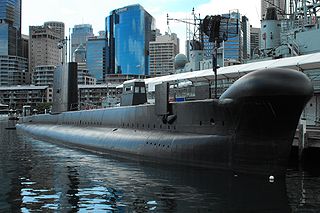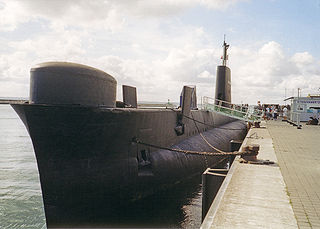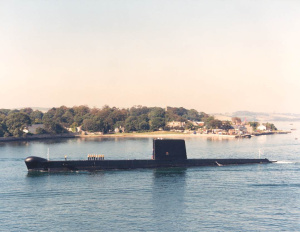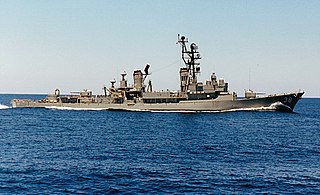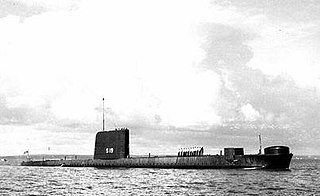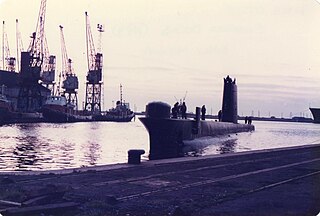
The Oberon class was a ship class of 27 British-designed submarines operated by five different nations. They were designed as a direct follow-on from the Porpoise class: physical dimensions were the same, but stronger materials were used in hull construction, and updated equipment was fitted. [1]
Contents
The submarines were built between 1957 and 1978 by four shipyards: Cammell Laird (4), Chatham Dockyard (6), Scotts Shipbuilding and Engineering Company (11) and Vickers-Armstrongs (6). [2] Thirteen of the submarines were operated by the Royal Navy, six by the Royal Australian Navy, three by the Brazilian Navy, three by the Royal Canadian Navy/Canadian Forces Maritime Command (plus two ex-Royal Navy boats later acquired for non-commissioned roles), and two by the Chilean Navy. [2]
The Oberons operated during the height of the Cold War, with duties including surveillance, tracking of other ships and submarines, delivery and retrieval of special forces personnel, and serving as targets for anti-submarine training. Submarines of the class were in service until 2000. As of 2015, eight of the submarines are preserved intact as museum vessels, another three are partially preserved (with some exterior portions of the submarine on display), and one is in private ownership and awaiting conversion for display. The rest have been sold for scrap, including one former museum vessel.
| Nation [2] | Name [2] | Pennant [2] [lower-alpha 1] | Builder [2] | Laid down [2] | Launched [2] | Commissioned [2] | Decommissioned | Status/Fate | Notes |
|---|---|---|---|---|---|---|---|---|---|
| United Kingdom | Oberon | S09 | Chatham Dockyard | 28 November 1957 | 18 July 1959 | 24 February 1961 | 1986 | Sold for scrap in 1991 | Lead ship of class |
| United Kingdom | Ocelot | S17 | Chatham Dockyard | 17 November 1960 | 5 May 1962 | 31 January 1964 | August 1991 | Preserved since 1992 at Chatham Historic Dockyard | |
| United Kingdom | Odin | S10 | Cammell Laird | 27 April 1959 | 4 November 1960 | 3 May 1962 | 18 October 1990 | Sold for scrap in 1991 | |
| United Kingdom | Olympus | S12 | Vickers-Armstrongs | 4 March 1960 | 14 June 1961 | 7 July 1962 | 1980s | Sold for scrap in 2011 | Operated by Canada from 1989 to the 1990s as a non-commissioned training vessel. |
| United Kingdom | Onslaught | S14 | Chatham Dockyard | 8 April 1959 | 24 September 1960 | 14 August 1962 | 1990 | Sold for scrap | |
| United Kingdom | Onyx | S21 | Cammell Laird | 16 November 1964 | 18 August 1966 | 20 November 1967 | 1991 | Sold for scrap in 2014 | A previous Oberon named Onyx became the Canadian Ojibwa during construction: this submarine was ordered as a replacement. Preserved from 1991 to 2006 by the Warship Preservation Trust, then from 2006 to 2014 by the Submarine Heritage Centre. |
| United Kingdom | Opportune | S20 | Scotts Shipbuilding | 26 October 1962 | 14 February 1964 | 29 December 1964 | 2 June 1993 | Sold for scrap | |
| United Kingdom | Opossum | S19 | Cammell Laird | 21 December 1961 | 23 May 1963 | 5 June 1964 | August 1993 | Sold for scrap | |
| United Kingdom | Oracle | S16 | Cammell Laird | 26 April 1960 | 26 September 1961 | 14 February 1963 | 18 September 1993 | Sold for scrap in 1997 | |
| United Kingdom | Orpheus | S11 | Vickers-Armstrongs | 16 April 1959 | 17 November 1959 | 25 November 1960 | 1987 | Sold for scrap in 1994 | Between 1987 and 1994 she served as a training vessel at HMS Dolphin. [3] |
| United Kingdom | Osiris | S13 | Vickers-Armstrongs | 26 January 1962 | 29 November 1962 | 11 January 1964 | 1989 | Sold for scrap in 1991 | Between 1988 and 1991, used by Canada as a parts hulk. |
| United Kingdom | Otter | S15 | Scotts Shipbuilding | 14 January 1960 | 15 May 1961 | 20 August 1962 | 31 July 1991 | Sold for scrap in 1992 | |
| United Kingdom | Otus | S18 | Scotts Shipbuilding | 31 May 1961 | 17 October 1962 | 5 October 1963 | 1990s | Preserved at Sassnitz, Germany | |
| Australia | Onslow | S60 | Scotts Shipbuilding | 4 December 1967 | 3 December 1968 | 22 December 1969 | 30 March 1999 | Preserved since 1999 at the Australian National Maritime Museum | |
| Australia | Orion | S61 | Scotts Shipbuilding | 6 October 1972 | 16 September 1974 | 15 June 1977 | 1996 | Sold for scrap in 2003. Fin preserved at Rockingham Naval Memorial Park. | |
| Australia | Otama | S62 | Scotts Shipbuilding | 25 May 1973 | 3 December 1975 | 27 April 1978 | 15 December 2000 | Sold for preservation in 2001 | |
| Australia | Otway | S59 | Scotts Shipbuilding | 29 June 1965 | 29 November 1966 | 23 April 1968 | 17 February 1994 | Sold for scrap in 1995. Fin and upper casing preserved at Holbrook, New South Wales | |
| Australia | Ovens | S70 | Scotts Shipbuilding | 17 June 1966 | 4 December 1967 | 18 April 1969 | 1 December 1995 | Preserved since 1998 at the Western Australian Maritime Museum | |
| Australia | Oxley | S57 | Scotts Shipbuilding | 2 July 1964 | 24 September 1965 | 21 March 1967 | February 1992 | Sold for scrap. Fin preserved at HMAS Stirling. Bow preserved at the Western Australian Maritime Museum | |
| Brazil | Humaitá | S20 | Vickers-Armstrongs | 3 November 1970 | 5 October 1971 | 18 June 1973 | 1996 | ? | |
| Brazil | Tonelero | S21 | Vickers-Armstrongs | 18 November 1971 | 22 November 1972 | 10 December 1977 | ? | ? | |
| Brazil | Riachuelo | S22 | Vickers-Armstrongs | 26 May 1973 | 6 September 1975 | March 1977 | 1997 | Preserved at the Navy Cultural Centre, Rio de Janeiro | |
| Canada | Ojibwa | S72 | Chatham Dockyard | 27 September 1962 | 29 February 1964 | 23 September 1965 | 21 May 1998 | Preserved since 2012 at the Elgin Military Museum | Originally laid down for the Royal Navy as Onyx, sold prior to launching. |
| Canada | Okanagan | S74 | Chatham Dockyard | 25 March 1965 | 17 September 1966 | 22 June 1968 | 14 September 1998 | Sold for scrap in 2011 | |
| Canada | Onondaga | S73 | Chatham Dockyard | 18 June 1964 | 25 September 1965 | 22 June 1967 | 28 July 2000 | Preserved since 2009 at the Site historique maritime de la Pointe-au-Père | |
| Chile | O'Brien | S22 | Scott Lithgow [lower-alpha 2] | 17 January 1971 | 21 December 1972 | 15 August 1976 | ? | Preserved in Valdivia, Chile | |
| Chile | Hyatt | S23 | Scott Lithgow [lower-alpha 2] | 10 January 1972 | 26 September 1973 | 27 September 1976 | ? | Sold for scrap in 2003 | |
